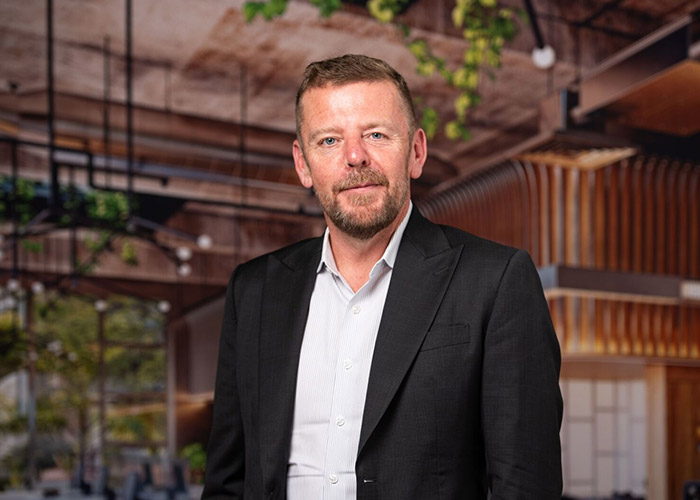How culture and strategic partnerships help fuel transformation
CIO.com’s
O’Sullivan
recently
spoke
with
Hale
about
developing
an
ever
evolving
mindset
for
digital
transformation
that
equally
strengthens
the
business
and
engagement
with
customers.
Watch
the
full
video
below
for
more
insights.

CIO.com’s
O’Sullivan
recently
spoke
with
Hale
about
developing
an
ever
evolving
mindset
for
digital
transformation
that
equally
strengthens
the
business
and
engagement
with
customers.
Watch
the
full
video
below
for
more
insights.
On
the
approach
to
transformation:
Each
role
I’ve
had
over
the
last
25
years
is
really
a
personal
transformation.
We
take
on
broader
roles,
more
senior
roles,
or
other
roles
in
the
organization
as
we
learn
about
the
business,
and
each
of
those
comes
with
its
own
challenges:
language
barriers,
cultural
barriers,
acronyms,
company
culture.
There’s
a
real
amount
of
change
that
comes
with
every
change
in
country
or
role.
It’s
a
personal
journey
of
discovery
and
a
way
of
getting
to
know
yourself
better
and
deeper,
too.
There
are
a
lot
of
challenges
we
face
day
to
day,
as
leaders,
but
in
each
role
we
take
on,
we
grow,
hopefully
learn
more
too,
and
become
a
little
wiser.
It’s
always
a
worry
if
we
treat
transformation
as
a
project
with
an
end
date.
It’s
about
continued
change.
For
me,
it
usually
starts
with
an
assessment
of
the
current
state—where
are
we,
from
a
technology,
people
and
skills
perspective.
That’s
the
foundation.
From
there,
it’s
important
to
engage
key
stakeholders.
In
my
role,
it’s
the
rest
of
the
executive
team
and
my
boss,
the
CEO,
who
make
sure
we
develop
a
shared
vision,
and
are
able
to
collectively
prioritize
once
that
vision
has
been
set
in
motion.
Things
change,
priorities
shift.
So
you
have
to
embrace
change
and
understand
that
change
management
is
a
continual
process.
Monitoring
progress
and
having
a
feedback
system
is
critical
as
well.
On
embracing
culture:
It’s
rare
that
anyone
would
step
into
a
greenfield
environment
and
have
something
to
build
from
scratch.
Legacy
systems
are
always
there.
How
legacy
they
are
will
somewhat
depend
on
the
business
and
the
role
that
someone
stepped
into.
But
legacy
systems
and
processes—often
very
intertwined—are
key
things
to
look
out
for,
and
not
underestimate
in
terms
of
the
complexity
they
can
bring.
Budget
constraints,
of
course,
are
ever
present
and
need
to
be
worked
through
very
closely.
One
of
my
key
relationships
is
with
the
CFO.
We
need
to
work
closely
to
understand
what
the
implications
are
of
taking
or
not
taking
certain
decisions
in
our
modernization
journey.
I
think
culture
is
a
big
piece
of
this
too.
As
technology
leaders,
we
need
to
understand
where
the
resistance
to
change
is,
and
try
to
face
into
that
early.
It’s
not
an
easy
conversation.
People
are
generally
wedded
to
the
way
we’ve
done
things—I
find
myself
in
this
group
as
well.
It’s
natural
to
want
to
be
more
efficient
and
more
effective
at
what
you
do,
so
changing
that
dramatically
is
uncomfortable.
And
trying
to
understand
whether
it’s
discomfort
because
of
the
fear
of
change,
or
through
lack
of
skills
is
an
important
differentiator.
Either
of
those
can
be
tackled,
but
if
you
get
them
wrong
and
try
and
tackle
it
with
the
wrong
solution,
it
can
become
harder.
On
combating
change
fatigue:
We
have
a
high
cadence
for
change.
I
think
there’s
no
fear
of
that.
But
it
needs
to
be
balanced
with
a
sense
of
progress
and
being
able
to
set
milestones
for
deliveries.
Often
things
will
need
to
run
as
projects,
and
other
things
will
live
as
longstanding
products
as
we
adopt
more
agile
ways
of
working.
There’s
a
real
balance
to
it
and
no
real
end
date
to
transformation;
it’s
a
continual
improvement
journey.
Sometimes
that
needs
to
be
accelerated,
and
acceleration
can
fit
more
naturally
with
transformation
because
it
feels
like
a
bigger
change
in
a
shorter
timeframe.
But
overall,
organizations
should
be
comfortable
being
in
constant
transformation,
and
people
should
feel
continuously
challenged
disrupting
themselves.
For
me,
ever
present
are
the
changes,
challenges,
and
making
sure
we
have
stability
and
availability
of
our
systems.
That
plays
into
change
management
and
being
able
to
address
how
continuous
change
is
in
an
organization.
On
collaboration
with
the
leadership
team:
There
are
a
number
of
stakeholders
that
the
role
has
and
we
meet
often.
I
have
one-to-ones
with
each
of
the
other
execs
and
it’s
where
we
can
really
get
into
the
detail
of
what’s
working,
what
isn’t,
and
where
some
of
those
priorities
might
be
shifting.
Ultimately,
it’s
about
time
and
being
accessible
as
an
extension
of
the
leadership
team
when
they’re
having
key
discussions.
It’s
also
about
making
sure
IT
can
be
pulled
into
conversations
at
the
right
time,
and
not
feel
like
an
isolated
part
of
the
business.
Being
able
to
show
adaptability
is
key.
Setting
forward
a
vision
and
being
too
stuck
with
a
direction
can
often
feel
like
IT
is
inflexible
and
not
agile.
So
being
able
to
demonstrate
building
platforms,
and
a
capability
that
enables
the
business
to
go
faster
really
builds
trust.
The
more
conversations
I
have
with
my
boss
and
with
my
peers
is
always
time
well
spent.











